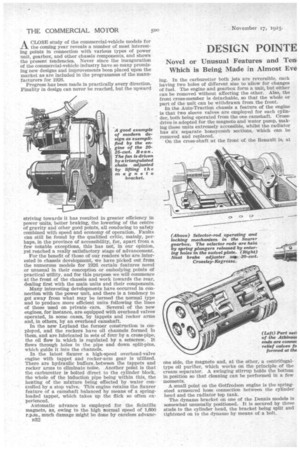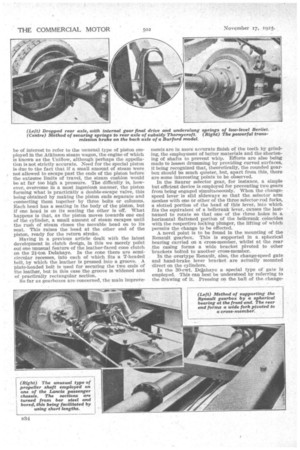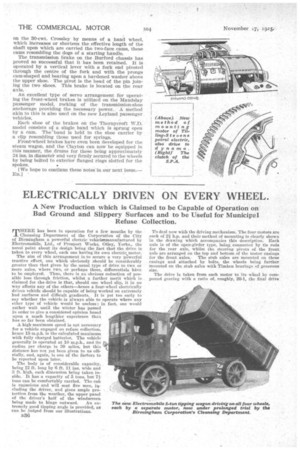DESIGN POINTE OM 1926 MODELS.
Page 16

Page 17

Page 18

Page 19

Page 20

If you've noticed an error in this article please click here to report it so we can fix it.
ACLOSE study of the commercial-vehicle models for the coming year reveals a number of most interesting points in connection with various types of power unit, gearbox, and other chassis components, and shows the present tendencies. Never since the inauguration of the commercial-vehicle industry have so many promising new designs and improvements been placed upon the market as are included in the programmes of the manufacturers for 1926.
• Progress has been made in practically every direction. Finality in design can never be reached, but the upward striving towards it has resulted in greater efficiency in power units, better braking, the lowering of the centre of gravity and other good points, all conducing to safety combined with speed and economy of operation. Faults can still be found by the qualified critic, mainly, perhaps, in the province Of accessibility, for, apart from a few notable exceptions, this has not, in our opinion, yet reached a really satisfactory stage of advancement.
For the benefit of those of our readers who are interested in chassis development, we have picked out from the numerous models for 1926 certain features novel or unusual in their conception or embodying points of practical utility, and for this purpose we will commence at the front of the chassis and work towards the rear, dealing first with the main units and their components.
Many interesting detelopments have occurred in connection with the power unit, and there is a tendency to get away from what may be termed the normal type and to produce more efficient units following the lines of those used on private cars. Several of the new • engines, for instance, are equipped with overhead valves operated, in some cases, by tappets and rocker arms and, in others, by an overhead camshaft.
In the new Leyland the former construction is employed, and the rockers have oil channels formed in them, and are lubricated in sets of four by a cross-pipe, the oil flow in which is regulated by a setscrew. It flows through holes in the pipe and down split-pins, which guide it into the channels.
In the latest Saurer a high-speed overhead-valve engine with tappet and rocker-arm gear is utilized. There are hydraulic buffers, between the tappets and rocker arms to eliminate noise. Another point is that the carburetter it bolted direct to the cylinder block, the whole of the induction pipe being within this, the heating of the mixture being effected by water controlled by a stop valve. This engine retains the Saurer feature of a camshaft balanced by means of a springloaded tappet, which takes up the flick so often experienced.
Automatic advance is employed for the Scintilla magneto, as, owing to the high normal speed of 1,600 r.p.m., much damage might be done by careless advanc
B 32 ing. In the carburetter both jets are reversible, each having two holes of different size to allow for changes of fuel. The engine and gearbox form a unit, but either can be removed without affecting the other. Also, the front cross-member is detachable, so that the whole or part of the unit can be withdrawn from the front.
In the Auto-Traction chassis a feature of the engine is that two sleeve valves are employed for each cylinder, both being operated from the one camshaft. Crossdrive is adopted for the magneto and water pump, making these units extremely accessible, whilst the radiator has six separate honeycomb sections, which can be removed and replaced.
On the cross-shaft at the front of the Renault is, at one side, the magneto and, at the other, a centrifugaltype oil purifier, which works on the principle of the cream separator. A swinging stirrup holds the bottom in poSition so that cleaning can be performed in a few moments.
A small point on the Gotfredson engine is the springsteel armoured hose connection between the cylinder head and the radiator top tank.
The dynamo bracket on one of the Dennis models is somewhat unusually positioned. It is secured by three studs to the cylinder head, the bracket being split and tightened on to the dynamo by means of a bolt. In the M. and D. engine the cylinders are cast in one with the upper half of the crankcase, the head is detachable and the camshaft is mounted above it, being driven by a vertical shaft with spiral bevels at each end. The upper camshaft pinion also drives, at one side, the magneto and, at the other, the dynamo; these units, being carried high, are ()tit of the way of dirt, heat and oil, and are also remarkably accessible. The cams operate pivoted levers and the pivot forks can be adjusted for height, thus increasing or reducing the • clearance, the valves being eccentric to the camshaft. The mounting of this unit is somewhat unusual. Instead of being fulcrumed at the front the trunnion • bearings, which, incidentally, are rubber bushes in.
thick, are situated about half-way along the crankcase, whilst the third point of mounting is at the back of the gearbox, where the unit is secured to the torqueball housing mounted on a cross-member. The arrangement strikes us as being most practical, as the weight is fairly evenly balanced around the central trunnions.
Another unusual method of engine mounting is to be found on the Maxwell-Chrysler van chassis, as the front end of the engine is carried on a laminated spring about 1 ft. wide, whilst at the rear rubber insulation prevents metallic contact. The fan also is mounted on the front end of the shaft of the Remy dynamo. A two-bladed fan made of wood and resembling a propeller is used on the S.P.A„ which also has front crossdrive to the pump and magneto.
Rocker-arm lubrication on the 24-seater Lailly passenger chassis is efficiently obtained by providing portm between the crankcase and the cylinder head, so that oil mist is constantly circulating. The tappet ends form cups into which fit the ball-ended pins of the rocking arms, the arrangement providing an oil cushion between each tappet and its rocker. A combined oil filler and breather is carried on the tappet gear cover.
A wood propeller is also used as a fan on the Lancia engine.
While on the subject of fans, we may point out that there is an increasing tendency towards driving these positively from the crankshaft. For instance, in the 20-25-cwt. Bean an enclosed silent-chain drive is employed. In this case the magneto is mounted on a bracket at the rear of the timing case, and upward movement of this bracket tightens the chain. In the Bean engine the circulation of the cooling water is thertno-siphonie, assisted by a pump.
In the Bristol engine the fan is driven by the silent timing chain, giving a 2 to 1 ratio, the drive incorporating a friction dutch.
The rear suspension of the engine on the subsidy Halley is by extension arms cast in one with the flywheel housing. Each arm rests on a rubber cushion, and is provided at the top with a second cushion to insulate the bolt from the metal.
The body of the fan on the Star power unit forms an oil reservoir, which is practically inexhaustible, as the oil, when the fan is working, is flung outwards by centrifugal force, and has no tendency to escape. Simple adjustment of the belt is afforded by a rocker arm, one end pivoted on a stud screwed into the cylinder, whilst the other end is formed as a vertical fork which can be moved up or down on a second stud.
*A feature of the 21-ton Delahaye is the unusually large Autovac, which, in this case, holds 21 -gallons, so that if anything ,gas wrong with the instrument the Autevac tank can be filled with petrol in the same way as a petrol tank.
One of the most interesting of the new engines is that on the Scammell autovan ; this is of the radial type with aluminium pistons having four narrow rings. One connecting rod has a big-end bearing on the crankpin, whilst the other two connecting rods are pivoted to extensions of this big-end. The valves are operated on the Bugatti system by a special type of cam ring, which runs at a quarter engine speed. In this gear, however, a machined phosphor-bronze tappet plate replaced the white-metal plate used by Bngatti. Before leaving the subject of engine design it will
be of interest to refer to the unusual type of piston employed in the Atkinson steam wagon, the engine of which is known as the Uniflow, although perhaps the appellation is not strictly accurate. Need for the special piston is due to the fact that if a small amount of steam were not allowed to escape past the ends of the piston before the extreme limits of travel, the steam cushion would be at far too high a pressure. The difficulty is, however, overcome in a most ingenious manner, the piston forming what is practically a double-escape valve, this being obtained by making the piston ends separate and connecting them together by three bolts or columns. Each head has a seating in the body of the piston, but if one head is on its seating the other is off. What happens is that, as the piston moves towards one end of the cylinder, a small amount of steam escapes until the rush of steam closes the movable head on to its seat. This raises the head at the other end of the piston, ready for the return stroke.
Having in a previous article dealt with the latest development in clutch design, in this we merely point out one unusual feature of the leather-faced cone clutch on the 2i-ton Delahaye. LEI the cone there are semicircular recesses, into each of which fits a T-headed bolt, by which the leather is pressed into a groove. A plate-headed bolt is used for securing the two ends of the leather, but in this case the groove is widened and of practically rectangular section.
So far as gearboxes are concerned, the main improve ments are in more accurate finish of the teeth by grinding, the employment of better materials and the shortening of shafts to prevent whip. Efforts are also being made to lessen drumming by providing curved surfaces, it being recognized that, theoretically, the rounded gearbox should be much quieter, but, apart from this, there are some interesting points to be observed.
In the Saurer selector gear, for instance, a simple but efficient device is employed for preventing two gears from being engaged simultaneously. When the changespeed lever is slid sideways so that the selector arm meshes with one br other of the three selector-rod forks, a slotted portion of the head of this lever, into which fits the equivalent of a bellcrank lever, causes the lastnamed to rotate so that one of the three holes in a horizontal flattened portion of the bellerank coincides with the respective locking plunger, the lifting of which permits the change to be effected.
A novel point is to be found in the mounting of the Renault gearbox. This is supported in a spherical bearing carried on a cross-member, whilst at the rear the casing forms a wide bracket pivoted to other brackets bolted to another cross-member.
In the overtype Renault, also, the change-speed gate and hand-brake lever bracket are actually mounted direct on the cylinders.
In the 30-cwt. Dejahaye a special type of gate is employed. This can best be understood by referring to the drawing of it. Pressing on the ball of the change speed lever forces down a stop so that the lever can be moved sideways or backwards and forwards. Releasing the pressure causes the stop to rise and engage with slots at the sides of the quadrant.
As regards rear axles, a new type of vertical-banjo axle, which permits the whole gear to be extracted without removing the casing, is found on the 'Oak provincial cab.
Another unusual type of axle is that on the new low load-line 30-cwt. Bernet. At first glance the axle appears to be the ordinary type, but closer inspection Shows that it is dropped below the centres of the wheels, arid that there is a second reduction by internal gears in the wheels, the gearing being totally enclosed. Incidentally, underslung springs are employed and the frame is slightly humped.
For details of other designs of rear axle we would refer our readers to a special article on the subject which appeared in our centre pages in the issue dated August 25th.
With the lengthening of the wheelbases of many chassis and the unit mounting of engines and gearboxes, it has been found necessary to split the propeller shaft into two, and sometimes three, sections, with a. centre bearing which obviates the whip caused by uneven running of a long Shaft. In most cases the construction follows what may be termed normal design, but an exception is to be found on the Garner, as, in this case, the middle section of the three-piece shaft is permitted to slide in a sleeve carried on roller bearings.
Most unusual, also, is the propeller, shaft adopted on one of the Lancia passenger chassis. This shaft is in four sections, bolted together, the reason being that each section is turned from the solid and bored through to obtain perfect balance, and it would be extremely difficult to bore out a shaft in one length.
It is notable that on the .Latil models Spicer joints are used for the caidan shafts leading from the differential to the pinions driving the wheels.
Brakes are naturally a subject of almost supreme interest in view of the higher vehicle speeds combined with road congestion. One brake, with novel features is to be found on the latest Super-Sentinel steam wagon. This is of the vacuum type, and the diaphragm is so arranged that the vacuumoccurs at one side only, where it is generated as required by exhaust steam. Consequently, the brake is applied rapidly, but gently. Normally, it is held -off by a spring.
In the Auto-Traction chassis four-wheel braking is employed, and the compensators, cross-shafts, etc., are all mounted on two castings bolted to the rear of a crossmember. The compensators are miniature whippie trees with ball ends.
In the Renault a feature of the servo-brake driven from the gearbox is that, apart from the servo-action, there is a positive connection between the pedal and the brakes, so that, should the servo device fail, the brakes could still be applied by foot.
Whipping of the brake rods is prevented on the 30-cwt. Dennis by supporting them in wide brackets secured to the torque tube.
A method resembling this is used on the M. and D. chassis, but in this case the rods are passed through slots in pieces of woven-fabric material hanging from the brackets.
In the S.P.A. the hand-brake and change-speed levers are somewhat unusually mounted on extensions of the gearbox casting. Both are centrally positioned.
There is a neat adjustment for the transmission brake on the 30-cwt. Crossley by means of a hand wheel, which increases or shortens the effective length of the shaft upon which are carried the two-face cams, these cams resembling the dogs of a starting handle.
The transmission brake on the Burford chassis has proved so successful that it has been retained. It is operated by a vertical lever with a fork end pivoted through the centre of the fork and with the prongs cam-shaped and bearing upon a hardened washer above the upper shoe. The pivot is the head of the pin joining the two shoes. This brake is located on the rear axle.
An excellent type of servo arrangement for operating the front-wheel brakes is utilized on the Maudslay passenger model, rocking of the transmission-shoe anchorage providing the necessary power. A Method akin to this is also used on the new Leyland passenger vehicles.
Each shoe of the brakes on the Thornycroft W.D. model consists of a single band which is sprung open by a cam. The band is held to the shoe carrier by a clip resembling those used for springs. Front-wheel brakes have even been developed for the steam wagon, and the Clayton can now be equipped in this manner, the drums for these being approximately 24 ins, in diameter and very firmly secured to the wheels by being bolted to exterior flanged rings Slotted for the spokes. •
[We hope to continue these notes'in.our next issue.—
En.]
































